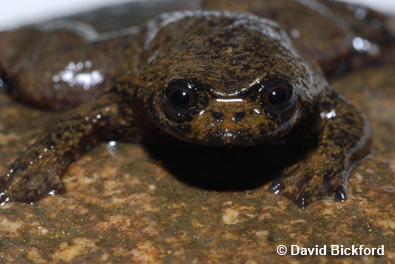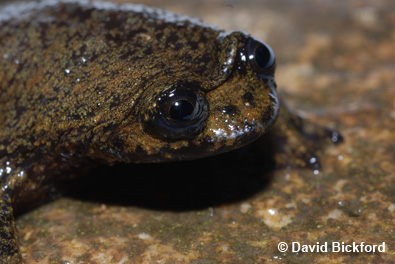The EDGE team are well aware of how the Plethodintid salamanders of Mexico evolved to have no lungs, breathing entirely through their skin and mouth lining, but we were amazed to hear last week that the first known species of lungless frog had been confirmed from the rainforests of Indonesia.
The Bornean flat-headed frog (Barbourula kalimantanensis) is ranked 152 on the EDGE Amphibians list, and is classified as Endangered by IUCN; the frog was known from just two specimens, collected nearly 20 years apart, until the recent expedition. This frog is a member of the Bombinatoridae family which diverged from all other amphibians over 200 million years ago, just before the Jurassic period. This family contains just ten species, half of which are threatened with extinction. The Bornean flat-headed frog has just one close relative, the Philippine flat-headed frog (Barbourula busuangensis), itself listed as Vulnerable to extinction.
Neither of the two previously known specimens has ever been dissected because, as expedition leader David Bickford of the National University of Singapore points out, “if you have just one specimen in your museum you don’t want to rip it open!”
It took two weeks of searching before the team found any of these small and elusive frogs, while searching in what might be the last remaining area where the species survives; the frog is found in clear, rocky, fast-flowing rivers in moist tropical forest, however their habitat has been degraded by pollution and siltation, a result of illegal gold mining and deforestation in the region.
Among tetrapods lunglessness is only known in amphibians, but within this class it has evolved three times, once in each of the amphibian orders: the frogs and toads, the salamanders, and the caecilians. In the case of salamanders a large number of lungless species exist – over 375 species! – however to date just one species of caecilian, and now one species of frog, are known to be lungless.
It is thought that, as with other lungless amphibians, the lack of lungs in the Bornean flat-headed frog is an evolutionary adaptation to the fast-flowing rivers in which the frogs live, as an individual with reduced or absent lungs is less likely to float away in the swift current than one with lungs.
The frog has evolved to have a flattened body, and therefore a larger surface area for gas exchange, which means that the high oxygen content in the fast-flowing stream is sufficient for the species to gain all the oxygen it requires. The team found that the other internal organs have moved to take up the space where the lungs would normally have been found.
Despite this fantastic discovery, very little is know about the biology and ecology of the endangered Bornean flat-headed frog, and the fast-disappearing habitat needs to be conserved if this unique species is to be protected.

